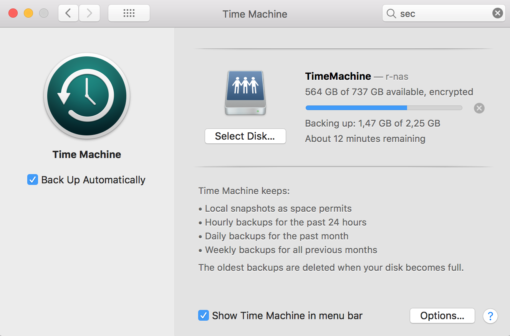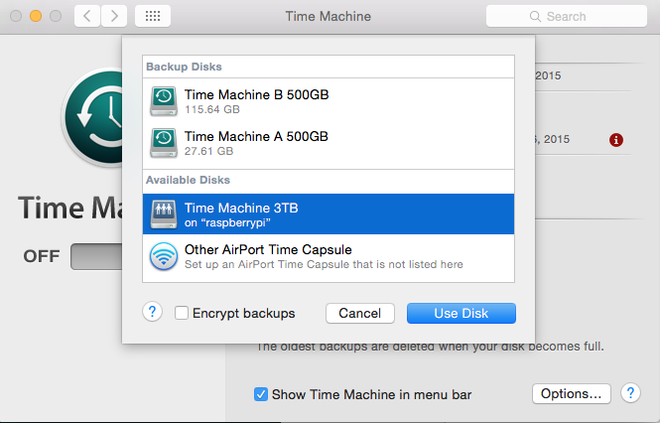
- #Raspberry pi netatalk time machine mac os x
- #Raspberry pi netatalk time machine install
- #Raspberry pi netatalk time machine software
If we used Apple’s HFS+ instead, we would be able to plug our drive directly into a Mac but we would have to disable journaling thereby losing write safety. We’re making a trade-off here: using ext4 means we won’t be able to plug our drive directly into a Mac and read and write to it but we benefit from the reliability of a journaled file system. Connecting it to my Raspberry Pi makes it instantly discoverable with blkid which will print attributes for all connected block $ sudo mkfs -t ext4 /dev/sda I use a cheap USB enclosure with a 500 GB hard disk inside and I want to use the whole disk for Time Machine. If you have this set up already, please feel free to skip ahead to Samba configuration. With our dependencies in place, let’s ready our storage. Note that we are not using Netatalk as we want to use SMB rather than AFP for file sharing as that seems to be the preferred file sharing protocol for network-attached storage in Apple’s current documentation. At the time of writing, the versions I used were Samba 4.9.5-Debian and avahi-daemon 0.7. It’s important to have a recent version of Samba so that we can benefit from the latest support for macOS-specific extensions. This way we don’t need to manually connect to our Raspberry Pi from our Mac, it will automatically appear both in the Finder’s sidebar and in the Time Machine System Preferences. This is all we really need to back up to storage attached to our Raspberry Pi but we can make it slightly easier to set up on the macOS end by also using Avahi’s implementation of the mDNS/DNS-SD protocol (sometimes called “Bonjour”) to make our Time Machine share automatically discoverable on our network. Samba is an open source implementation of the SMB file sharing protocol which is officially supported by Time Machine for backing up over a network.
#Raspberry pi netatalk time machine install
With Raspbian up and running, let’s install the two packages we’re going to need: Samba and the Avahi $ sudo apt install samba avahi-daemon At the time of writing, I used the September 2019 version of Raspbian Buster with a kernel version of 4.19. If not, please see the official documentation for installing a Raspberry Pi operating system image on an SD card.
#Raspberry pi netatalk time machine software
I’m going to use an external hard drive connected via USB but the same principles should apply to any storage available to the Raspberry Pi.įirst, ensure you’re using a recent version of Raspbian so we can rely entirely on Debian packages already built for your Raspberry Pi and avoid compiling software ourselves (which can take quite some time on older models).

We’re going to use a Raspberry Pi (I used an old Model B) as a cheap alternative to a dedicated Network-attached Storage (NAS) device for use with Time Machine. However, Time Machine can also be configured to back up to storage elsewhere on your network and not directly connected to your computer.

#Raspberry pi netatalk time machine mac os x
Ever since Mac OS X Leopard, connecting an external storage device to your Mac will ask you if you want to use that storage to automatically back up all of your files with a feature called Time Machine.


 0 kommentar(er)
0 kommentar(er)
